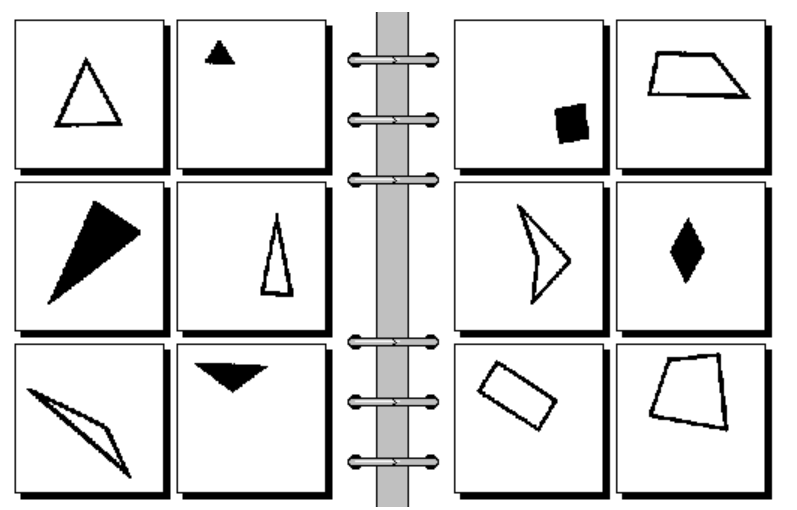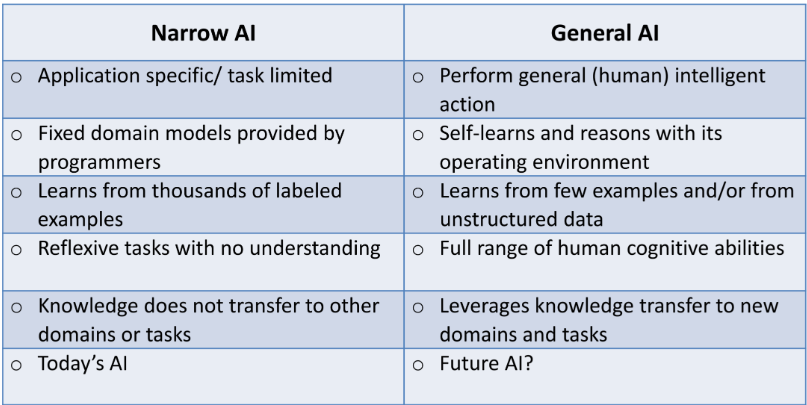This article was published as a part of the Data Science Blogathon.
Introduction
Let’s begin with a fun mind-teasing activity, shall we?

Can you find the relation between the shapes on the left and the ones on the right?
These are Bongard’s Puzzles for you, 100 of them designed by the Soviet computer scientist Mikhail Bongard, who was working on pattern recognition in the 1960s. There have been significant advances in AI and ML since then, with deep neural networks winning numerous pattern recognition contests and even showing superhuman performance in some cases. That’s the power of AI!
But wait, let’s first get down to the basics, shall we?
Let’s get started!
What is AI?
In the simplest terms, AI is an abbreviation for Artificial Intelligence. It is just a concept to mimic the human brain to perform tasks that can iteratively improve itself based on the information it collects as feedback.

A few use cases you might have come across are the chatbots you encounter in banking or customer care setups, your OTT platform recommending new web series for you to watch based on the genres you like, and so on.
There are 4 types of AI:
- Reactive AI- The most basic type of artificial intelligence is programmed to provide a predictable output based on the input it receives. They cannot learn actions dynamically or conceive of the past or future and hence can’t function beyond the tasks they were built for. Examples include Deep Blue, the chess-playing IBM supercomputer that bested world champion Garry Kasparov, spam filters for our email, and the Netflix recommendation engine.
- Limited memory AI- The most widely used AI today, limited memory AI learns from the past and builds experiential knowledge by observing actions or data. This type of AI uses historical, observational data in combination with pre-programmed information to make predictions and perform complex classification tasks. Examples include autonomous vehicles.
- Theory of mind AI- The goal is to make machines that can understand and remember emotions, then adjust behavior based on those emotions as they interact with people. Examples include the humanoid robot Sophia, developed in Hong Kong.
- Self-aware AI- Probably the most human-like AI, with needs, desires, and emotions, leading machines to have a level of consciousness and intelligence similar to human beings.
A more apt new-age definition of AI could also be Augmented Intelligence. Augmented intelligence is a design pattern for a human-centered partnership model of people and AI working together to enhance cognitive performance, including learning, decision-making, and new experiences.
The 1988 vision for AI And the Progress Made in that Regard
Listed below are a few of the vision statements proposed by Turing Award winner and Moza Bint Nasser University Professor at CMU, Raj Reddy, in his 1988 Presidential address to the Association for the Advancement of Artificial Intelligence and their current status.
1. World Champion Chess –
Completed ( While IBM Deep Blue was the first machine to beat a reigning world champion in 1997, come 2017, Google’s AlphaZero even beat the world’s best chess program Stockfish 8, after teaching itself the rules of chess in just under 4 hours)
2. Mathematical Discoveries –
Mathematicians have started understanding the importance of AI for breakthroughs in their field, which wasn’t initially believed to be possible because of the notion that computers could not help them develop intuition or suggest a possible line of attack. A few notable examples include Google’s DeepMind training models to predict certain quantities called Kazhdan-Lusztig polynomials, discovering new theorems in the mathematical field of knot theory, etc
3. Accident Avoiding Car, now popularly known as self-driving cars –
More than half of the goal is achieved (in technical terms, we’re at level L3~L4, and the goal is to reach the completion level of L5). There are impediments to the goal, though, a major one being that even if we reach L5, we’re not going to have just self-driving cars plying on the streets. We will probably just see a slight decrease in the number of human drivers, not a complete wipeout as is the ideal case for computational certainty. The mere uncertainty human factors bring raises serious questions about road safety ( an apt example is the 2018 Arizona Tesla crash, where a self-driving SUV hit and killed an unassuming pedestrian).
4. Self-replicating systems –
Work is underway in this regard, and we’ve noticed a lot of breakthroughs at the molecular level for now, with self-producing and catalyzing molecules, peptide networks, etc. at the forefront
These examples were for you to reflect on how AI was envisioned to be almost 35 years back and what we have as a STEM society achieved in all these years while also motivating you about interesting areas you can try to explore and bring a fresh perspective into.
What are the Avenues for AI in the Current Decade and Challenges They Bring?
There are a lot of avenues AI can revamp through careful consideration and implementation. I’ve tried to skim over a few below:
a. Health:
– Nursing homes/Old age homes: 90% of the resident care can be done by robots/ smart infrastructure. A fine example was the COVID clusters functioning by navigation-controlled bots in the later part of the pandemic
– Assistance for a patient with dementia( evaluate working via performance thresholds)
– Wearable devices – Automatic alerts for clinical consultations, fall detection, auto summoning an ambulance, etc
b. Wealth:
– Thrift assistant: Can go through monthly payments like mortgage and auto insurance etc while e-negotiating lower payments for the same asset and coverage levels
– Savings assistant: Saving automatically towards specific consumption goals: eg. college education, retirement fund, etc, and alerting when not tracking the desired trajectory.
– Benefits assistant: scrape for government schemes ensuring quick credits to the end user wallets without fraud, overheads, and any hassle of paperwork, even for people with limited digital infrastructure.
c. Wisdom:
– Law: Successfully arguing a case before a judge (On an unrelated note, do you think it would be harder to defend than being a plaintiff’s AI counsel?)
– Information checker for extracting and discarding fake news and misinformation with dialog and nuanced explanations.
We need to focus on minimizing the obstacles in the path to achieving all these use cases. We have to realize that we work better together as a team, and we need to constantly upskill and reskill to make ourselves capable of solving these problems. We need to approach every problem open-mindedly, give our ethics more thought and consideration, and just power on with drive and motivation!
Where are we Currently, and What Ways to Bridge the Gap?

We are currently in the Narrow AI domain, which focuses on building AI for a specific task, domain, or region. AGI or artificial general intelligence is the most- human-like AI we envision having in the future, with the most striking human-like capabilities imbued with multidimensional common sense and reasoning.
Moving from Narrow AI to AGI involves actionable goals we can work on, like –
- Procuring alternate sources of data can pave the way for proactive intelligence.
- Wide spreading of the adoption of ensemble techniques for models as well as datasets.
- Building trust for more wholehearted adoption of AI into sensitive applications.
- Reconsidering ethics and isonomy in such systems
- Drawing synergies in combining AI with quantum computing and behavioral sciences.
Bridging the gap will require considering causality (human-like decision-making) and correcting imperfect logic and plausible reasoning. Appropriate data and domain knowledge go without saying. We require more robust algorithms that give us a grounding in perception. For instance, a lot of language perception comes from human experience, and the day machines can replicate that intuition, we will have achieved the pinnacle of AI.
Emerging Economies and the Issues They Bring with Them
AI’s ballooning carbon footprint is the main impetus to the growth of AI today in emerging economies, particularly with the push towards sustainability.
AI has an increased role in the post-pandemic world: Intrapreneurship and Entrepreneurship implications. Bridging the gap between the ones controlling AI production and the end consumers is vital today.
Innovative, bold initiatives that capture the imagination of researchers and system builders are often required to spur a field of science or technology forward. What we need to do collectively is to work together to build responsible AI that’s accurate and bias-free, trained with local as well as general domain data with a mindful way of using minimum resources yet getting maximum output.
Conclusion
Grand challenges are important as they act as compasses for researchers and practitioners alike — especially young professionals — who ponder worthwhile problems to work on, testing the boundaries of what is possible! What we’ve tried to do today is to unleash the competitive streak in everyone by listing the challenges and our current progress in our mission to tackle them head-on. The reason listing down impediments in the path to achieving something is fundamental is that it helps chalk out actionable plans and deadlines to substantiate the goal. The end goal is to make AI more human-centric and independent, to make life easier and much more productive.
Steve Jobs, decades ago, waxed eloquently on the amplification of human ability by referring to the superlative efficiency of a man with a bicycle in the context of personal computers. His belief of humans being the best tool builders there can possibly be is particularly relevant today in the context of human-AI teaming and collective intelligence applied to particularly novel problems.
Key Takeaways:
-
We looked at AI as a simulation of human intelligence processes by machines and a quick overview of the umpteen use cases in which AI can be applied.
-
We took a quick glimpse at the vision laid down for AI in the 1980s and where we, as a society, currently stand to achieve those. A lot of inspiration for new ideas to delve into the field can be drawn from this section.
-
We briefly overview the avenues AI brings, particularly focusing on three broad umbrella areas of health, wealth, and wisdom.
-
We also looked at the narrow and general AI as a current and future prospect of AI and ways in which we can bridge the gap between the two.
-
Finally, we looked at the main impetus for emerging economies and what we need to keep in mind as we move forward with AI.
I hope this article was helpful; I’d be glad if you could take away even something from the discussion we had today.
Until next time!
The media shown in this article is not owned by Analytics Vidhya and is used at the Author’s discretion.








Iam very glad to see this article.God give more energy and capability to do to good engineering society